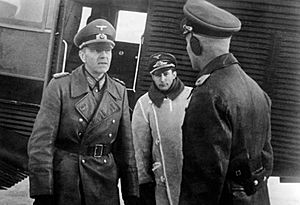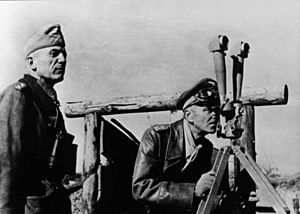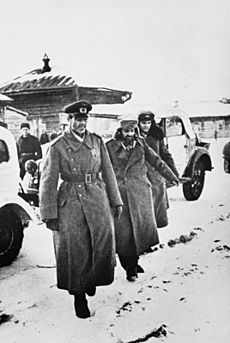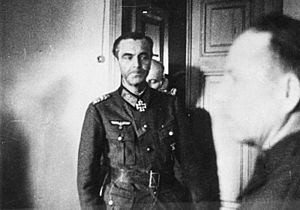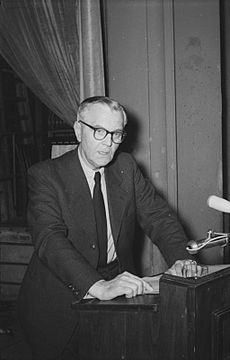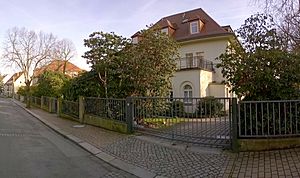Friedrich Paulus facts for kids
Quick facts for kids
Friedrich Paulus
|
|
|---|---|
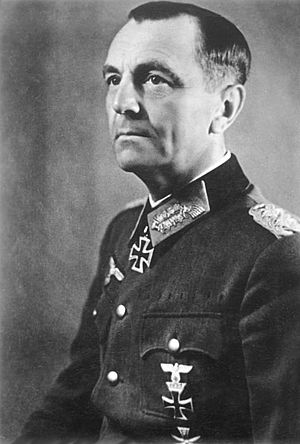
Lieutenant General Friedrich Paulus (June 1942)
|
|
| Birth name | Friedrich Wilhelm Ernst Paulus |
| Born | 23 September 1890 Guxhagen, Kingdom of Prussia German Empire |
| Died | 1 February 1957 (aged 66) Dresden, East Germany |
| Allegiance | |
| Branch | |
| Years of service | 1910–45 1953–56 |
| Rank | |
| Commands held | Sixth Army |
| Battles/wars | World War I
|
| Awards | Knight's Cross of the Iron Cross with Oak Leaves |
| Alma mater | Marburg University |
| Spouse(s) |
Constance Elena Rosetti-Solescu
(m. 1912; died 1949) |
| Signature | |
Friedrich Paulus (born 1890, died 1957) was a German field marshal during World War II. He is most famous for leading the Sixth Army during the important Battle of Stalingrad. This battle, from August 1942 to February 1943, was a huge disaster for the German army. Soviet forces surrounded the Germans in the city. Most of the 265,000 soldiers in the Sixth Army were either killed or captured.
Paulus fought in World War I in France and the Balkans. He was seen as a promising officer. By the start of World War II, he had become a major general. He took part in the invasions of Poland and France. Later, he helped plan the invasion of the Soviet Union, called Operation Barbarossa.
In 1942, Paulus was given command of the Sixth Army. He had little experience leading such a large force. He led the attack towards Stalingrad. However, Soviet forces launched a counter-attack and surrounded his army. Adolf Hitler ordered Paulus not to retreat or surrender. The German defenses slowly weakened. Paulus finally surrendered in Stalingrad on January 31, 1943. On that same day, Hitler had promoted him to field marshal.
While held captive by the Soviets, Paulus openly criticized the Nazi government. He joined a group called the National Committee for a Free Germany. In 1953, Paulus moved to East Germany. There, he worked on military history research. He lived the rest of his life in Dresden.
Contents
Early Life and Military Start
Paulus was born in Guxhagen, Germany. He grew up in Kassel. His father was a treasurer. He tried to join the German Navy but was not successful. For a short time, he studied law at Marburg University.
Many books and articles from the 1940s often added "von" to Paulus's name. This made it sound like he was from a noble family. However, this is incorrect. Paulus's family was not part of the nobility. Historians describe his background as quite humble.
Joining the Army and Marriage
Paulus left university without finishing his degree. In February 1910, he joined the 111th Infantry Regiment. He started as an officer cadet. On July 4, 1912, he married Constance Elena Rosetti-Solescu. She was Romanian and the sister of a fellow officer.
When World War I began, Paulus's regiment moved into France. He fought in the Vosges mountains and near Arras in 1914. After being ill, he joined the Alpenkorps as a staff officer. He served in France, Romania, and Serbia. By the end of the war, he had become a captain.
Between the World Wars
After World War I ended, Paulus worked as a brigade adjutant. He was one of only 4,000 officers chosen for the Reichswehr. This was Germany's small army, limited to 100,000 men by the Treaty of Versailles. He was a company commander in Stuttgart. For more than ten years (1921–1933), he held various staff positions. In the 1920s, he even gave lectures in Moscow, Soviet Union. This was part of military cooperation between Germany and the Soviet Union.
Later, Paulus briefly commanded a motorized battalion (1934–1935). In October 1935, he became chief of staff for the new Panzer headquarters. This new group trained and developed Germany's tank forces, called the Panzerwaffe.
World War II and Key Roles
In February 1938, Paulus became chief of staff for Gen. Heinz Guderian's new XVI Armeekorps. Guderian described Paulus as "brilliantly clever" and "hard working." However, Guderian worried about Paulus's lack of decisiveness and command experience. Paulus stayed in this role until May 1939.
He was then promoted to major general. He became chief of staff for the German Tenth Army. With this army, he served in Poland. The unit was later renamed the Sixth Army. It fought in the spring attacks of 1940 through the Netherlands and Belgium. Paulus was promoted to lieutenant general in August 1940. The next month, he became deputy chief of the German General Staff. In this role, he helped create the plans for the invasion of the Soviet Union, known as Operation Barbarossa.
Eastern Front and the Battle of Stalingrad
In November 1941, Paulus was promoted to General der Panzertruppe. He became commander of the Sixth Army. This was a big step, as he had never commanded a unit larger than a battalion. He took command on January 20, 1942.
Paulus led the attack on Stalingrad that summer. His troops fought Soviet forces for over three months. The fighting was very harsh and took place in the city streets. In November 1942, the Soviet Red Army launched a huge counter-attack. This attack, called Operation Uranus, surrounded Paulus's army. Paulus did not ask to leave the city when the attack began.
Paulus followed Adolf Hitler's orders to hold his positions in Stalingrad. This was despite being completely surrounded by strong Soviet forces. A rescue effort, Operation Winter Storm, was launched in December. It was led by Field Marshal Erich von Manstein. Paulus prepared to break out of Stalingrad. But he kept his army in fixed defensive positions. Manstein told Paulus that the rescue needed help from the Sixth Army. However, the order to start the breakout never came. Paulus remained firm in obeying his orders. Manstein's forces could not reach Stalingrad on their own. Their efforts were stopped by other Soviet attacks.
Kurt Zeitzler, the new chief of the Army General Staff, finally convinced Hitler to let Paulus try to break out. But Hitler still demanded that Paulus hold Stalingrad, which was an impossible task.
For the next two months, Paulus and his men kept fighting. But they ran out of food and ammunition. Their equipment was lost, and the German soldiers became weaker. This slowly wore down their defense. In the new year, Hitler promoted Paulus to colonel general.
The Crisis and Surrender
On January 7, 1943, General Konstantin Rokossovsky of the Red Army offered Paulus's men a chance to surrender. The terms were generous: normal food, medical care for the wounded, and permission to keep their uniforms and personal items. Rokossovsky told Paulus that his situation was impossible. Paulus asked Hitler for permission to surrender. Even though the Sixth Army was clearly in a hopeless position, the German High Command refused. They said, "Surrender out of the question. Every day that the army holds out longer helps the whole front."
After a heavy Soviet attack captured the last emergency airstrip on January 25, the Soviets again offered Paulus a chance to surrender. Paulus radioed Hitler once more for permission. He told Hitler that collapse was "inevitable." Paulus stressed that his men had no ammunition or food. He also said that 18,000 men were wounded and needed urgent medical care. Again, Hitler refused Paulus's request. He ordered him to hold Stalingrad until death.
On January 30, Paulus told Hitler that his men were only hours from collapse. Hitler responded by giving many field promotions to Paulus's officers. He wanted to boost their spirits and their will to fight. Most importantly, he promoted Paulus to field marshal. Hitler noted that no Prussian or German field marshal had ever surrendered. Hitler implied that if Paulus was captured alive, he would bring shame to Germany's military history.
The Capitulation
Paulus and his staff were captured on the morning of January 31, 1943. Colonel Wilhelm Adam, one of Paulus's aides, wrote about these events in his diary.
On February 2, 1943, the rest of the Sixth Army surrendered. When Hitler found out about Paulus's surrender, he became very angry. He vowed never to appoint another field marshal again. (However, he did appoint seven more field marshals later in the war.) Speaking about Paulus's surrender, Hitler told his staff:
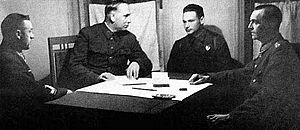
Paulus had forbidden his soldiers from standing up in their trenches to be shot by the enemy. Shortly before surrendering, Paulus sent his wedding ring back to his wife. It was on the last plane leaving his position. He had not seen her since 1942. He would not see her again, as she died in 1949 while he was still a prisoner.
After Stalingrad and Postwar Life
At first, Paulus refused to cooperate with the Soviets. However, after the attempted assassination of Hitler on July 20, 1944, he changed his mind. While in Soviet captivity, he became a strong critic of the Nazi government. He joined the Soviet-supported National Committee for a Free Germany. This group urged other Germans to surrender. He later spoke as a witness for the prosecution at the Nuremberg Trials.
In 1953, he was allowed to move to the German Democratic Republic (East Germany). This was two years before other German prisoners of war were sent home. During the Nuremberg Trials, a journalist asked Paulus about the Stalingrad prisoners. He told the journalist to tell their families that their loved ones were well. However, of the 91,000 German prisoners taken at Stalingrad, half died on the march to prison camps in Siberia. Nearly as many died in captivity. Only about 6,000 survived and returned home.
After returning to East Germany in 1953, Paulus held a press conference in Berlin on July 2, 1954. He spoke about "the vital issues of our nation."
From 1953 to 1956, Paulus lived in Dresden, East Germany. He worked as the civilian head of the East German Military History Research Institute. In late 1956, he was diagnosed with amyotrophic lateral sclerosis, a serious illness. He became weaker over time. He died a few months later in Dresden, on February 1, 1957, at age 66. This was exactly 14 years and one day after his surrender at Stalingrad. In his will, he asked for his body to be taken to Baden-Baden, West Germany. He was buried next to his wife, who had died eight years earlier in 1949. She had not seen her husband since he left for the Eastern Front in 1942.
Images for kids
See also
 In Spanish: Friedrich Paulus para niños
In Spanish: Friedrich Paulus para niños



